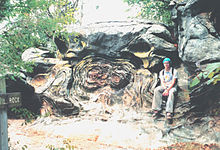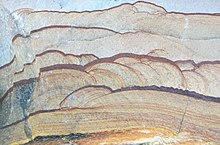Liesegang rings (geology)

Liesegang rings (/ˈliːzəɡɑːŋ/) (also called Liesegangen rings or Liesegang bands) are colored bands of cement observed in sedimentary rocks that typically cut across bedding.[1][2] These secondary (diagenetic) sedimentary structures exhibit bands of (authigenic) minerals that are arranged in a regular repeating pattern.[3] Liesegang rings are distinguishable from other sedimentary structures by their concentric or ring-like appearance. The precise mechanism from which Liesegang rings form is not entirely known and is still under research,[4] but there is a precipitation process that is thought to be the catalyst for Liesegang ring formation, referred to as the Ostwald-Liesegang supersaturation-nucleation-depletion cycle.[5] Though Liesegang rings are considered a frequent occurrence in sedimentary rocks,[6] rings composed of iron oxide can also occur in permeable igneous and metamorphic rocks that have been chemically weathered.[7]
History
In 1896, a German Chemist named Raphael E. Liesegang first described Liesegang banding in his observations from the results of an experiment, and Wilhelm Ostwald provided the earliest explanation for the phenomenon.[8][9][10][11] The purpose of Liesegang's experiment was to observe precipitate formation resulting from the chemical reaction produced when a drop of silver nitrate solution was placed onto the surface of potassium dichromate gel. The resultant precipitate of silver dichromate formed a concentric pattern of rings. Liesegang and successive other workers observed the behavior of precipitates forming rings in sedimentary rocks, hence these features became known as Liesegang rings.[3]
Mechanism for development



The process by which Liesegang rings develop is not completely understood.[4] Liesegang rings may form from the chemical segregation of iron oxides and other minerals during weathering.[2] One popular mechanism suggested by geochemists is that Liesegang rings develop when there is a lack of convection (advection) and has to do with the inter-diffusion of reacting species such as oxygen and ferrous iron that precipitate in separate discrete bands which become spaced apart in a geometric pattern.[10] A process of precipitation known as the Ostwald-Liesegang supersaturation-nucleation-depletion cycle is known by the geologic community as a probable mechanism for Liesegang ring formation in sedimentary rocks.[5] In this process the "...diffusion of reactants leads to supersaturation and nucleation; this precipitation results in localized band formation and depletion of reactants in adjacent zones."[5] As Ostwald suggests, there is a localized formation of crystal seeds that occurs when the right level of supersaturation is reached, and once the crystal seeds form, the growth of the crystals is believed to lower the supersaturation level of fluids in pore spaces surrounding the crystals, thus mineralization that occurs after the initial crystal growth in the surrounding areas develops in bands or rings.[10] One classic example based on the Ostwald-Liesegang hypothesis is observed in water and rock interactions where iron hydroxide precipitates in sandstone through pore space.[10]

Occurrence in the environment
Liesegang ring patterns are considered to be secondary (diagenetic) sedimentary structures, though they are also found in permeable igneous and metamorphic rocks that have been chemically weathered.[7] Chemical weathering of rocks that leads to the formation of Liesegang rings typically involves the diffusion of oxygen in subterranean water into pore space containing soluble ferrous iron.[7] Liesegang rings usually cut across layers of stratification and occur in many types of rock, some of which more commonly include sandstone and chert.[3] Though there is a high occurrence of Liesegang rings in sedimentary rocks,[6] relatively few scientists have studied their mineralogy and texture in enough detail to write more about them.[12] Liesegang rings are referred to as examples of geochemical self-organization, meaning that their distribution in the rock does not seem to be directly related to features that were established prior to Liesegang ring formation.[13] For instance, in certain types of sedimentary rocks such as carbonate siltstones (calcisiltites), Liesegang ring patterns can be misinterpreted for faults; the rings may appear to be "offset," however the laminae in the rock exhibit an unbroken pattern, therefore the observed offset is attributed to pseudofaulting.[7] Pseudofaults are the result of Liesegang rings developing within areas of the rock that are adjacent to each other but at varying stratigraphic levels.[7] Liesegang rings can have the appearance of fine lamination and can be mistaken for laminae when parallel or subparallel to the bedding plane, and are more easily differentiated from laminae when the rings are observed cutting across beds or lamination.[2]
References
- ^ Jackson, Julia A., 1997. "Glossary of Geology." American Geological Institute, Alexandria, Virginia. 4th edition. P. 366
- ^ a b c Stow, A.V., 2009, Sedimentary rocks in the field. A color guide (3rd ed.), Pp. 103, 107.
- ^ a b c Middleton, Gerard V.; Church, Michael J.; Coniglio, Mario; Hardie, Lawrence A.; Longstaffe, Frederick J.; 2003. "Encyclopedia of Sediments and Sedimentary Rocks." Kluwer Academic Publishers, Dordrecht. Pp. 221, 224.
- ^ a b Krug, H.-J,. Brandtstadter, H., and Jacob, K.H., 1996. Morphological instabilities in pattern formation by precipitation and crystallization processes. Geologische Rundschau, 85: 19-28.
- ^ a b c Decelles, P.G., and Gutschick, R.C., 1983. Mississippian wood-grained chert and its significance in the western interior United States. Journal of Sedimentary Petrology, 53: 1175-1191.
- ^ a b Merino, E., 1984. Survey of geochemical self-patterning phenomena. In Nicolis, G., and Baras, F. (eds.), Chemical Instabilities. Dordrecht: D. Reidel Publishing Company, pp. 305-328.
- ^ a b c d e McBride, E. F. (2003), Pseudofaults resulting from compartmentalized Liesegang bands: update. Sedimentology, 50: 725–730. doi:10.1046/j.1365-3091.2003.00572.x
- ^ Liesegang, R. Ed. (1896). "A-Linien" [A lines]. Photographisches Archiv (in German). 37: 321–326.
- See also: Liesegang, R. Ed. (1896). "Ueber einige Eigenschaften von Gallerten" [On some properties of gelatin]. Naturwissenschaftliche Wochenschrift (in German). 11 (30): 353–362. See especially pp. 357–359.
- ^ Ostwald, Wilhelm (1897). "A-Linien von R. E. Liesegang" [A lines of R. E. Liesegang]. Zeitschrift für Physikalische Chemie, Stöchiometrie und Verwandtschaftslehre (in German). 23: 365.
- See especially: Ostwald, Wilhelm (1896–1902). "§151. Experimenteller Nachweis der Übersättigungsgrenze. [§151. Experimental proof of the limit of supersaturation.]". Lehrbuch der allgemeinen Chemie [Textbook of general chemistry] (in German). Vol. 2, part 2 (2nd ed.). Leipzig, Germany: Wilhelm Engelmann. pp. 777–780.
- ^ a b c d Steefel, Carl I., 2008, Geochemical Kinetics and Transport: in Brantley, Susan L; Kubicki, James d; White, Art F. (eds), Kinetics of Water-Rock Interaction, Springer New York, p. 545-589.
- ^ English physical chemist J. R. I. Hepburn noted that investigators preceding Liesegang had made observations of periodic precipitation in gels. See:
- Hepburn, J. R. I. (1923). "The Liesegang Phenomenon—an historical note". Nature. 112 (2812): 439. Bibcode:1923Natur.112..439H. doi:10.1038/112439b0.
- Periodic precipitation of copper salts in potassium silicate: Lupton, Sydney (1892). "Dendritic forms". Nature. 47 (1201): 13–14. Bibcode:1892Natur..47...13L. doi:10.1038/047013a0.
- Periodic precipitation of calcium oxalate in isinglass gel: Ord, William Miller (1879). The Influence of Colloids upon Crystalline Form and Cohesion. London, England: Edward Stanford. pp. 107–108.
- ^ Fu, L., Milliken, K.L., and Sharp, J.M. Jr., 1994. Porosity and permeability variations in fractured and Liesegang-banded Breathitt sandstones (Middle Pennsylvanian), eastern Kentucky: diagenetic controls and implications for modeling dual-porosity systems. Journal of Hydrology, 154: 351-381.
- ^ Chen, W., Park, A., and Ortoleva, P., 1990. Diagenesis through coupled processes: modeling approach, self-organization, and implications for exploration. American Association of Petroleaum Geologists Memoir 49, Prediction of Quality Through Chemical Modeling. pp. 103-130.
